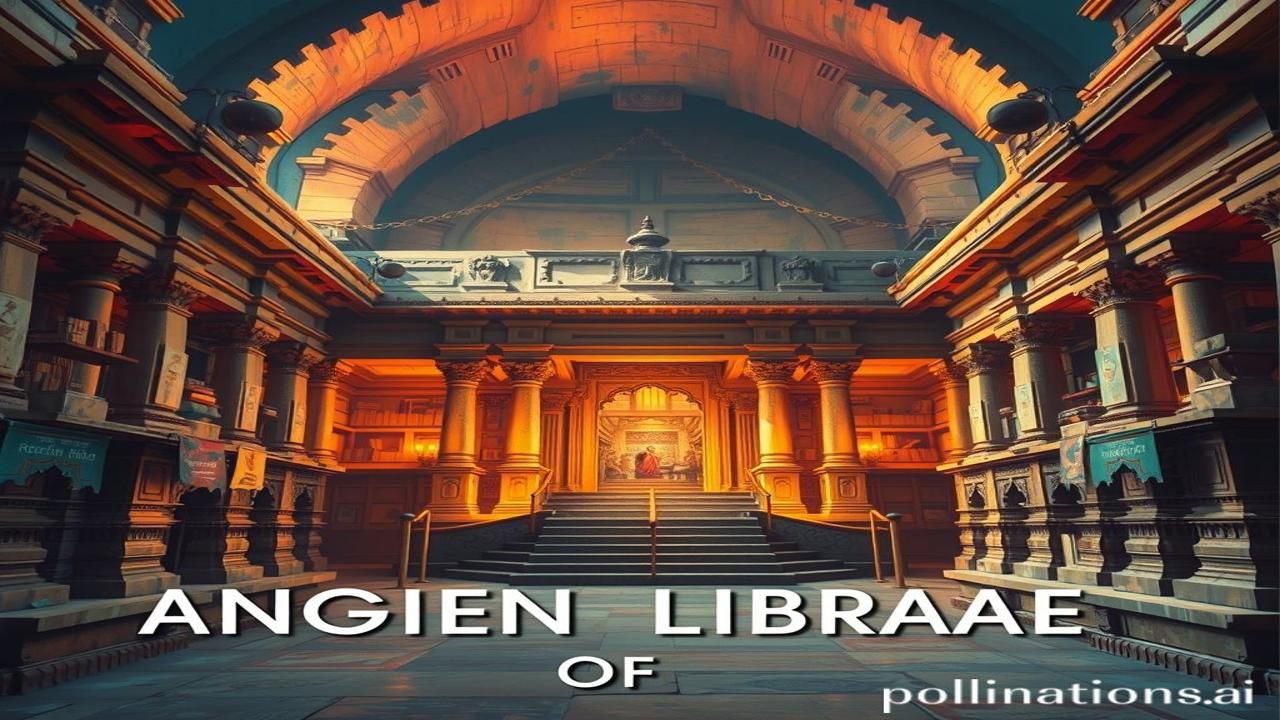Waqt Ke Panno Mein Khoi Hui: Ancient Libraries of India
Kabhi socha hai, agar hum apne purane, khoye hue itihas ki galiyon mein ghoom sakte, toh kya dekh paate? Imagine yourself, dust swirling around your ankles, the scent of aged parchment and sandalwood incense filling your lungs. A faint whisper echoes… it’s the voices of scholars long gone, their wisdom etched onto palm leaves, carefully preserved in the heart of ancient libraries. These weren’t just buildings full of books; they were the nerve centers of knowledge, the repositories of Bharatiyata itself.
Ancient Libraries: Jaha Gyan Shakti Tha
Ancient Indian libraries were far more than just storage spaces for manuscripts. They were vibrant centers of learning and cultural exchange. Think of places like Nalanda, Taxila (Takshashila), Vikramshila, and Vallabhi – names that resonate with intellectual prowess even today. These universities, often attached to magnificent monasteries, flourished between the 5th century BCE and the 12th century CE.
These libraries weren’t just about religious texts. They housed knowledge on everything imaginable – mathematics, astronomy, medicine (Ayurveda), philosophy, grammar, and even statecraft (Arthashastra). Their importance lay in preserving and disseminating this knowledge, ensuring that it reached generations of scholars and thinkers. These libraries also played a vital role in cultural transmission, allowing for the exchange of ideas between different parts of India and beyond, attracting students from as far away as Tibet, China, and Korea.
Zameeni Sach: Acharyas, Bhikshus, aur Gyan Ki Talaash
Imagine a young scholar, let’s call him Aryak, making his way to Nalanda in the 7th century CE. He’s travelled for months, his heart filled with a burning desire to learn. The air vibrates with the chanting of monks as he approaches the massive library complex. He can smell the earthy aroma of the palm leaves, meticulously inscribed with ancient wisdom.
Inside, Aryak finds himself surrounded by fellow seekers of knowledge. He sees Acharyas (teachers), passionately debating philosophical concepts. He witnesses Bhikshus (monks) carefully copying manuscripts, ensuring their preservation for future generations. He spends his days poring over texts on mathematics and astronomy, his mind expanding with each new discovery.
Ma Rukmini, a lekhipika (scribe), dedicates her life to copying religious manuscripts, each stroke of her stylus a prayer. Her hands, though calloused, moved with grace and devotion, preserving the ancient verses for generations to come. These libraries were not just about grand halls and ancient scrolls; they were about the people who breathed life into them, dedicated individuals who cherished knowledge above all else.
Dharohar aur Pehchan: Echoes of the Past in the Present
Although these ancient libraries themselves no longer stand in their full glory, their legacy continues to resonate in modern India. The emphasis on education, the reverence for knowledge, and the spirit of inquiry are all echoes of that glorious past. We see it in our universities, our research institutions, and even in our homes, where books are still considered sacred objects.
The concept of gurukul, where knowledge is passed down from teacher to student in a nurturing environment, is a direct descendant of the educational system that thrived in these ancient libraries. The principles of Ayurveda and Yoga, meticulously documented in these libraries, are now embraced globally as holistic approaches to health and well-being. Our continued reverence for Sanskrit and other ancient languages is a testament to the enduring power of the knowledge preserved within those walls.
Mazedar Tathya ya Bhram-Bhanjak: The Burned Pages & Hidden Gems
Log samajhte hain ki sabse badi library Nalanda thi, lekin Vikramshila University library, though less famous, rivaled Nalanda in its collection of Tantric texts and esoteric knowledge. Sadly, many ancient libraries were destroyed during invasions and periods of political upheaval. The burning of the Nalanda library is a particularly tragic event, resulting in the loss of countless invaluable manuscripts. However, not all knowledge was lost. Many manuscripts were carefully hidden away or taken to other countries, and scholars are still working to uncover and decipher these forgotten treasures.
Drishya aur Bhavnaen: The Scent of Ink and Whispers of Wisdom
Imagine the sun streaming through the latticed windows of the library at Vallabhi. The air is thick with the scent of sandalwood incense and old parchment. The rhythmic scratching of quills on palm leaves fills the silence, punctuated by the occasional hushed debate between scholars. The walls are adorned with intricate carvings depicting scenes from ancient epics. You can almost feel the weight of history pressing down, the collective wisdom of generations whispering through the halls. You touch a cool stone pillar, worn smooth by centuries of hands, and feel a connection to the scholars who stood in the same spot, seeking enlightenment.
Antim Vichar ya Uddharan: The Eternal Flame
The ancient libraries of India may be gone, but the flame of knowledge they ignited continues to burn bright. They serve as a powerful reminder of the importance of preserving our cultural heritage and fostering a spirit of intellectual curiosity.
“ज्ञानं परमं ध्येयम्” (Jnanam Paramam Dhyeyam) – Knowledge is the supreme goal. Let us strive to uphold this ideal and continue the quest for knowledge that began in the hallowed halls of our ancient libraries.
